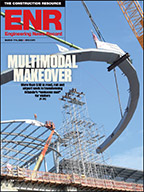 |
| DEMONSTRATION Attendees of the National Asphalt Pavement Association convention in Phoenix learn about new noise monitoring technology. |
Urged on by residents tired of excessive highway noise, Arizona Dept. of Transportation engineers are progressing with landmark efforts of quiet-pavement designs.
After public complaints peaked in 2001, ADOT in 2002 topped 13 miles of the 12-in.-thick concrete surface of U.S. 60 in Phoenix with a 1-in.-thick, open-graded friction course (OGFC). The hot-mix asphalt was modified at the plant with a 20% crumb-rubber binder made from recycled tires. The publics response was unexpected, says George Way, ADOTs chief pavement-design engineer. "They started calling in and saying, This is incredibly quiet. Why dont you pave the whole freeway this way?"
 |
Last spring, ADOT initiated the Quiet Pavements Program, a $34-million overlay of 115 miles in Phoenix with OGFC, or rubberized asphalt. The job is set to finish in 2007. ADOT is also conducting a 10-year noise study that is attracting national interest. The $1-million study is underwritten by the Federal Highway Administration, says Larry Scofield, ADOT materials engineer. Its highlight is a computerized, close-proximity (CPX) noise meter designed by Scofield and engineers at Auburn Universitys National Center for Asphalt Technology in Auburn, Ala. FHWA funded the $160,000 development costs.
Pulled by a pickup truck, the trailer-mounted unit resem-bles an overgrown Battlebot and quantifies road noise at the wheel. It noted a 3 to 5 dB improvement in Arizona with the OGFC overlay. NCAT built another $70,000 trailer to benchmark road noise in other states.
|
The units are expected to generate landmark data in the quest for silent roads. "Surface type does matter, because noise should be controlled at the source," says Scofield. "To my knowledge, this is the first time asphalt has been used just to quiet the pavement," adds Charles A. Adams, president of Howell Paving Inc., Mattoon, Ill, who listened to the results on Jan. 20 during an ADOT-guided tour at the National Asphalt Pavement Associations annual convention in Phoenix.
 |
| PAVING THE WAY Arizona "rubberized" roads reduce noise. |
Other states, such as California, have experimented with rubber and polymers on asphalt and concrete, but "ADOT is the leader in implementing this," says Gerald A. Huber, associate research director of Heritage Research Group, Indianapolis. John Bukowski, FHWA senior pavement engineer, agrees: "Arizonas program seems to be the most recognized on a national level."
Monolithic noise walls, costing about $1 million to $5 million per road-mile, are the only method currently recognized by federal noise-reduction specifications, says Way. OGFC rubberized asphalt costs $100 to $200 more per ton than a routine mix but may save on wall-building costs. "We are not saying that the pavements can be used in replacement to noise walls," says Bukowski. "We are just looking at one more tool."
(Photos by Tudor Hampton for ENR)


